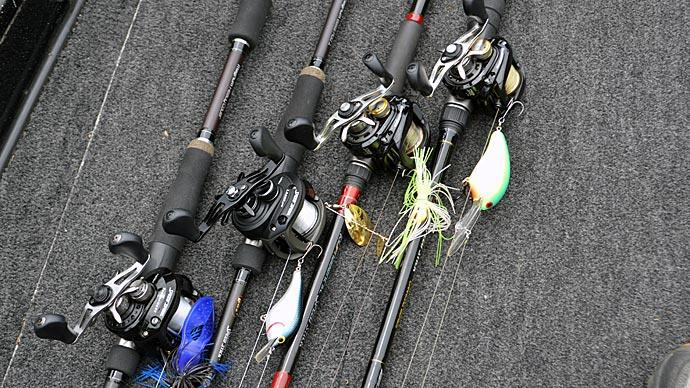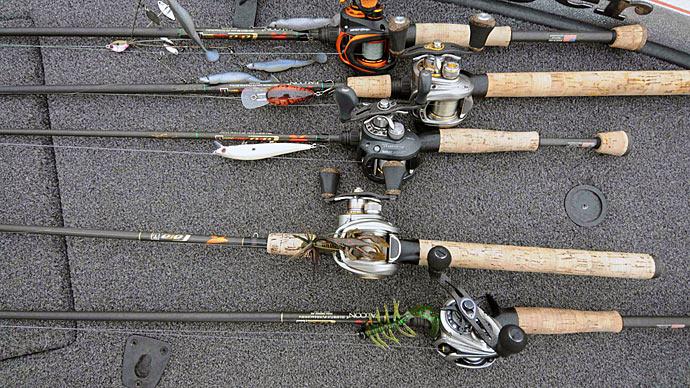
Matching the right rod and reel to the lure or fishing technique, and knowing what line type and size works best sounds complicated, but it's actually basic common sense and logic. If you match these tools properly you can cast faster and better and even the more experienced angler can be more comfortable fishing, more accurate casting and make your time on the water more enjoyable.
We've all heard the terrible sound (woof) that means the line on the reel has turned into a bird's nest, a backlash or professional overrun. There are several things that can cause this to happen, even to an experienced angler. But you can reduce these backlashes with a better match between the rod, reel, line and lure.
Monofilament comes in basically two types a flexible, or limp, line that has some stretch, but is very forgiving when cast and has less memory. The other is a more abrasion resistant, less stretch and usually retains some memory and tends to hold a coil when it's been on the reel for a while adding to your chances for a backlash.
Braided line has a smaller diameter compared to monofilament for the same line size and is typically limp. It is used for flipping and pitching in heavy cover where high strength and good abrasion resistance is needed.
In between are some new co-polymers and fluorocarbons that are abrasion resistant, soft without memory and invisible in the water.
Next are the rods. Most of the better rods are 100% graphite, with the exception of some of the crankbait rods, which are fiberglass, or a combination of graphite and fiberglass. Fiberglass is highly flexible, more forgiving and works well fishing diving crankbaits. Baitcasting rods come in several different variations. This will be a personal choice item. The main factor is to get a good quality, sensitive rod. Some shorter rods have pistol grip handles, but most now have a longer straight handle called a trigger stick handle. The old thought was to use long rods for flipping and short pistol grip for casting lures. That's changed a lot now and you don't see as many pistol grip rods. Rod length is a personnel preference and the old school was not to use a rod longer than you were tall, but the longer the rod the further you can cast and the less effort is needed to reach that target.
Most new graphite rods are light in weight and are balanced at the reel seat. That means you can set the rod handle on your finger with the reel attached and the rod should balance equally from tip to the end of the handle. The rods will have weight markings near the handle of light, medium light, medium, medium heavy, heavy, etc. and also suggested lure and line sizes also.
Reels, have evolved from the old direct drive, sleeve bearing to the works of art they are today. Most of the new baitcasting style reels have some kind of a braking system, (either magnetic or centrifugal) to help slow the spool and control backlash problems. They all have a spool tension adjustment to set how fast the line comes off of the spool. The more ball or needle bearings that a reel has the smoother its operation and typically the more expensive it gets. Two, three or more ball bearings will be a good starting reel.
Now is the time to put your rod, reel and line combination together and we need to select a lure to make this match up. Let's make it a 1/4-ounce spinnerbait.
Let's start with the rod and as I said before rod length is your choice, but for the purpose of this combination we will use a 6-1/2-foot rod. A medium light or medium would be a good choice and you need to use a rod that shows a lure range of 1/8- to 3/8-ounce for a 1/4-ounce spinnerbait. The rod will also give you a line weight to use, typically 8- to 14- or 10- to 17-pound for medium light to medium action rods.
Next we need a good three or more ball bearing reel with a braking system. The reels also have a suggested line size on them and you should stick to those also.
Now that we have the rod and reel together, the line is easy. We will choose 15-pound line. After the line is spooled on, make the reel adjustments for the lure. First, with the lure at the top of the rod allow it to fall as you adjust the spool tension on the side of the reel. You want a slow to medium steady fall, not just an instant drop to the floor. Do this several times until you have a slow, smooth fall from the tip of the rod to the floor. Next, start with a midrange on the braking system. On the centrifugal brake pull out about half of the weights and on the magnetic system, dial to about 5 or 6 on the scale. You can make a few casts and fine tune the braking system from here to the point where, when the lure hits the water the line stops feeding off the spool.
The rod will do all of the work, once you have put the right combination together. With this balanced fishing tool, you should be able to cast all day without getting tired.
You should only use your forearm and wrist to cast; your shoulder is not involved. Practice casting with a sheet of paper under your arm, keeping your elbow to your side. This is the proper form for casting. Easier said then done!
Bonita is sponsored by Cobra Boats, Mercury Motors, Bowie Marine, Hamby's Protectors, Solargizer, Falcon Rods, Bob's Machine Shop, Minn Kota, OutdoorTexas.com and Tournament Chasers.




